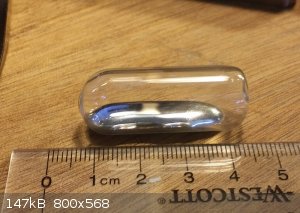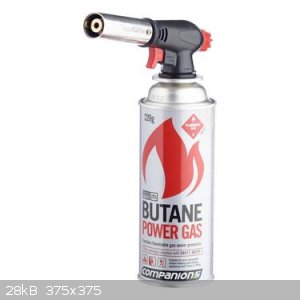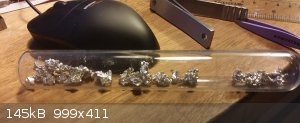rasiel
Harmless

Posts: 20
Registered: 8-2-2016
Member Is Offline
Mood: No Mood
|
|
How do I seal a glass ampoule in inert atmosphere?
Hey everyone,
What is the most practical way of sealing off a test tube inside a glove box filled with argon? Can't really use a torch in there ;-)
Thanks for any tips!
Ras
|
|
|
Detonationology
Hazard to Others
  
Posts: 362
Registered: 5-5-2015
Location: Deep South
Member Is Offline
Mood: Electrophillic
|
|
Welcome to the forum!
"Storage of air sensitive compounds. The most straightforward method to store air and moisture
sensitive compounds is to keep them inside a glovebox. However, one has to take into account that the
compounds inside a glovebox are protected from air and moisture, but not from other compounds that
are being used inside. A fail-safe storage method is to isolate a compound in an ampoule and to seal this
ampoule under a protective atmosphere or under vacuum using a blowtorch.
When transferring a solid into an ampoule, it often happens, that part of the material will end up stuck
to the glass wall. This will frustrate sealing of the ampoule, as the hot flame of the blowtorch will burn
the compound and thus prevent proper sealing. Therefore, it is recommended to clean the glass wall.
When sealing compounds in an ampoule under inert atmosphere, it is necessary to do so using an
outflow of the protective gas (i.e. take the stopper off). In the case that an ampoule will be sealed while
the ampoule is closed off, expansion of the protective gas as a result of heating the gas will cause the
ampoule to burst open."
Read more here
“There are no differences but differences of degree between different degrees of difference and no difference.” ― William James
|
|
|
j_sum1
Administrator
       
Posts: 6218
Registered: 4-10-2014
Location: Unmoved
Member Is Offline
Mood: Organised
|
|
Low tech method -- to be used when no glovebox is available. Method will be improved if you have access to a glovebox.
Put sample in the ampoule.
If necessary, use a flame to narrow the opening until nearly closed. (Needed if you are using a test tube or something wide for an ampoule.)
Flood the ampoule with argon. (Even easier with a glovebox.)
Stopper the ampoule. (Remove from glovebox.)
Seal with a flame as normal.
|
|
|
rasiel
Harmless

Posts: 20
Registered: 8-2-2016
Member Is Offline
Mood: No Mood
|
|
Thanks for the responses. Having here at home a DIY glovebox I'd love to try the first option but despite the PDF I'm not sure on the mechanics of how
this is actually done. Obviously the torch needs a supply of oxygen from outside - or possibly rig it up so that the tip is firing through a port hole
while the rest of the torch is outside. But both cases seem really awkward.
In the meantime I could try the low tech method. It should work for the stuff that doesn't oxidize too readily.
Thanks again!
Ras
|
|
|
j_sum1
Administrator
       
Posts: 6218
Registered: 4-10-2014
Location: Unmoved
Member Is Offline
Mood: Organised
|
|
I have not had too much experience with this and I really don't have a way of testing my result. But it hasn't been too difficult. I have a cylinder
of argon and can feed the gas into the bottom of the ampoule using a pasteur pipette. I can then remove the pipette quickly and put a stopper in. I
suppose I could do it in a zip-lock plastic bag to lessen the amount of air that is able to get in before stoppering.
Once the ampoule has a stopper in it then I can flame-seal the ampoule at leisure.
|
|
|
ahill
Hazard to Self
 
Posts: 57
Registered: 8-1-2015
Member Is Offline
Mood: triumphant
|
|
I've just been doing a bit of this myself - and am pretty pleased with the technique I came up with ...much as j_sum1 suggests ..I seal one end of a
glass tube that is quite a bit longer than I need, pop it in a glovebox (if necessary), place the sample in, squirt a bit of argon in, then stuff the
end with cotton wool. Finally I remove the tube from the glovebox, then, moving quickly, with a torch heat the middle between the cotton wool and
sample and seal it, discarding the cotton wool end.
I got my argon from a bottle shop - its for keeping wine, and came in a can with a thin rubber tube that I can place deep in the unsealed ampule so as
to be sure to displace all the existing atmosphere. If I stuff the wool around the rubber tube while its still in the ampule I can actually skip the
whole glovebox altogether.
|
|
|
Heavy Walter
Hazard to Others
  
Posts: 127
Registered: 17-12-2015
Location: Argentina
Member Is Offline
Mood: No Mood
|
|
I use the "low tech method" and also freezing the compound inside the ampoule, in order to reduce flame issues with some solvents.
|
|
|
rasiel
Harmless

Posts: 20
Registered: 8-2-2016
Member Is Offline
Mood: No Mood
|
|
Ok, I think I understand the method pretty well now.... and it would work too except I don't have ampoules but rather test tubes. Anyone have any tips
of closing off a 12mm neck by the fire of a propane torch?
I have argon and can flood the tubes straight in as you guys describe.
Thanks all y'all's :-)
Ras
|
|
|
rasiel
Harmless

Posts: 20
Registered: 8-2-2016
Member Is Offline
Mood: No Mood
|
|
To give an idea of what I'm trying to accomplish, here is an "ampoule" of the sort I'm trying to make. It's just glass tubing sealed off on both sides
with the sample inside, in this case mercury.

|
|
|
Detonationology
Hazard to Others
  
Posts: 362
Registered: 5-5-2015
Location: Deep South
Member Is Offline
Mood: Electrophillic
|
|
How did you seal it and how do you plan to recover the Hg without having glass bits in it? Most ampules are twisted into a point at the top end,
which can easily be snapped off. The design you have shown would be better for an something that is not intended to be removed, like for an element
collection.
“There are no differences but differences of degree between different degrees of difference and no difference.” ― William James
|
|
|
j_sum1
Administrator
       
Posts: 6218
Registered: 4-10-2014
Location: Unmoved
Member Is Offline
Mood: Organised
|
|
I use test tubes for ampoules quite often.
You can pre-narrow them if needed.
They usually taper to a point but if you are careful you can get a blunt end and you can make it rounder by pressing on something.
Making an ampoule that is nearly full is harder because the heating is closer to your sample. I suspect that the one shown was done with solid
mercury.
Oh, and pulling is better than twisting for a nice-looking seal.
|
|
|
rasiel
Harmless

Posts: 20
Registered: 8-2-2016
Member Is Offline
Mood: No Mood
|
|
The mercury ampoule is not my creation, it's what I'm trying to replicate and reverse engineer. And, yes, it is actually for an element collection so
a one way trip :-)
I did just try sealing with a torch and it's just a mess. I can get the edges soft but any pressure to bend it in results in little cracks along the
edges or the softened glass to stick to the tool I'm using to push. That's with regular glass, borosilicate might be much more resistant to cracking
but that much harder to melt. In the end, the bigger question is whether there's a better method for sealing wide neck glass than filling with argon.
I now have a good handle on that last part at least.
Ras
|
|
|
j_sum1
Administrator
       
Posts: 6218
Registered: 4-10-2014
Location: Unmoved
Member Is Offline
Mood: Organised
|
|
I use a butane torch similar to this one.

It is up to the job, but only just. Take your time to fully heat the test tube -- rotating so that it heats evenly in the area where you want it. Do
not attempt to put any pressure on the glass until it begins to sag under its own weight. Then pull gently to narrow. Don't try to bend or twist.
For mercury, I would create a narrow neck and let the glass cool. Then I would put the mercury in. I probably would not be so ambitious to put too
much in but leave a decent space in the ampoule. Then (if possible) chill the Hg to freezing. Next put Ar in and stopper it. Finally sealing off
the narrow neck in a flame can be done quite quickly. For a nice finish I would continue to heat after it has sealed and then round off the end.
There is no substitute for practice. But by the time you have ruined a dozen or so test tubes you will have a better feel for how the glass behaves
in your flame.
[edit] smallifying image
[Edited on 10-2-2016 by j_sum1]
[Edited on 10-2-2016 by j_sum1]
|
|
|
rasiel
Harmless

Posts: 20
Registered: 8-2-2016
Member Is Offline
Mood: No Mood
|
|
Thank you! Very informative. Off to the garage after I'm done with this post!
In the case of mercury no need for argon since it's air stable. I want to do this for other elements that aren't. Like this calcium below; to transfer
it from a huge ampoule into little ones each holding what looks and feels like metal popcorn.

|
|
|
Herr Haber
International Hazard
    
Posts: 1236
Registered: 29-1-2016
Member Is Offline
Mood: No Mood
|
|
One of my suppliers sells equipment that use IR. It's made to bend twist and form your own glassware without a flame.
Wanna bend a glass rod, a pipette, a test tube? That would be my choice.
I was looking into it because this equipment car reach temperatures far beyond a normal heating plate / mantle AND can be used as such for
distillations that need really hot temperatures.
|
|
|
rasiel
Harmless

Posts: 20
Registered: 8-2-2016
Member Is Offline
Mood: No Mood
|
|
Well, that sounds wonderful. What is IR? Whar is this tech, whar?
|
|
|
Herr Haber
International Hazard
    
Posts: 1236
Registered: 29-1-2016
Member Is Offline
Mood: No Mood
|
|
Infra Red.
This supplier supplies anything from glassware to autoclaves big enough for hospitals etc.
I guess I saw this in one of the older catalogues along other Equipment to sterilize by heat.
But basically, it was a heating resistance with a "grate" or I dont know how to describe what was on top except is was purposedly made so you could
put your pipette or you glass rod Inside and then wait for it to be hot enough to do all the bending or clamping needed.
I mostly remembered it because this item was more or less "cheap" when compared to all the other stuff they sold.
|
|
|
Detonationology
Hazard to Others
  
Posts: 362
Registered: 5-5-2015
Location: Deep South
Member Is Offline
Mood: Electrophillic
|
|
This is an example of a IR heat gun.
This sounds similar to what Haber is talking about; however, I am unsure that even with localized heating, it would be capable of reaching the
temperatures needed to seal a borosil ampule.
I highly doubt it would work, but I just thought I'd share.

“There are no differences but differences of degree between different degrees of difference and no difference.” ― William James
|
|
|
Herr Haber
International Hazard
    
Posts: 1236
Registered: 29-1-2016
Member Is Offline
Mood: No Mood
|
|
A heat gun is usefull in many other occasions but that not what I was thinking about 
I found a website with the description of the electric burner I had in mind in English:
http://www.dutscher-scientific.co.uk/frontoffice/product?pro...
I hope this helps !
|
|
|
Texium
|
Thread Moved
22-11-2023 at 20:05 |